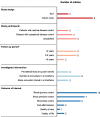Optimizing the frequency of physician encounters in follow - up care for patients with type 2 diabetes mellitus: a systematic review
- PMID: 38279105
- PMCID: PMC10811944
- DOI: 10.1186/s12875-024-02277-9
Optimizing the frequency of physician encounters in follow - up care for patients with type 2 diabetes mellitus: a systematic review
Abstract
Background: Decisions on the frequency of physician encounters for patients with type 2 diabetes mellitus (T2DM) have significant impacts on both patients' health outcomes and burden on health systems, whereas definitive intervals for physician encounters are still lacking in most clinical guidelines. This study systematically reviewed the existing evidence evaluating different frequencies of physician encounters among T2DM patients.
Methods: Systematic search of studies evaluating different visit frequencies for follow - up care in T2DM patients was performed in MEDLINE Ovid, Embase Ovid, and Cochrane library from database inception to 25 March 2022. Studies on the follow - up encounters driven by non - physicians and those on the episodic visits in the acute care settings were excluded in the screening. Citation searching was conducted via Google Scholar on the identified papers after screening. The risk of bias was assessed using Cochrane RoB2 tool for randomized controlled trials and Newcastle - Ottawa Scale for cohort studies. Findings were summarized narratively.
Results: Among 6363 records from the database search and 231 references from the citation search, 12 articles were eligible for in - depth review. The results showed that for patients who had not achieved cardiometabolic control, intensifying encounter frequency could enhance medication adherence, shorten the time to achieve the treatment target, and improve the patients' quality of life. However, for the patients who had already achieved the treatment targets, less frequent encounters were equivalent to intensive encounters in maintaining their cardiometabolic control, and could save considerable healthcare costs without substantially lowering the quality of care and patients' satisfaction.
Conclusion: Existing evidence suggested that the optimal frequency of physician encounters for patients with T2DM should be individualized, which can be stratified by patients' risk levels based on the cardiometabolic control to guide the differential scheduling of physician encounters in the follow - up. More research is needed to determine how to optimize the frequency of physician encounters for this large and heterogeneous population.
Keywords: Follow - up care; Physician encounters; Risk stratification; Type 2 diabetes mellitus.
© 2024. The Author(s).
Conflict of interest statement
The authors declare no competing interests.
Figures



Similar articles
-
Beyond the black stump: rapid reviews of health research issues affecting regional, rural and remote Australia.Med J Aust. 2020 Dec;213 Suppl 11:S3-S32.e1. doi: 10.5694/mja2.50881. Med J Aust. 2020. PMID: 33314144
-
Community-based care for the management of type 2 diabetes: an evidence-based analysis.Ont Health Technol Assess Ser. 2009;9(23):1-40. Epub 2009 Oct 1. Ont Health Technol Assess Ser. 2009. PMID: 23074528 Free PMC article.
-
Metformin for prevention or delay of type 2 diabetes mellitus and its associated complications in persons at increased risk for the development of type 2 diabetes mellitus.Cochrane Database Syst Rev. 2019 Dec 3;12(12):CD008558. doi: 10.1002/14651858.CD008558.pub2. Cochrane Database Syst Rev. 2019. PMID: 31794067 Free PMC article.
-
Promoting and supporting self-management for adults living in the community with physical chronic illness: A systematic review of the effectiveness and meaningfulness of the patient-practitioner encounter.JBI Libr Syst Rev. 2009;7(13):492-582. doi: 10.11124/01938924-200907130-00001. JBI Libr Syst Rev. 2009. PMID: 27819974
-
Patient-physician communication of health and risk information in the management of cardiovascular diseases and diabetes: a systematic scoping review.BMC Med. 2025 Feb 21;23(1):96. doi: 10.1186/s12916-025-03873-x. BMC Med. 2025. PMID: 39984943 Free PMC article.
Cited by
-
Physician-Visit Frequency and Its Impact on Glycemic Control in People With Type 2 Diabetes: Quantifying Care Acceptance Parameters From Retrospective Electronic Health Record Data.Cureus. 2024 Dec 28;16(12):e76527. doi: 10.7759/cureus.76527. eCollection 2024 Dec. Cureus. 2024. PMID: 39877765 Free PMC article.
-
Lifestyle Interventions for Treatment and Remission of Type 2 Diabetes and Prediabetes in Adults: A Clinical Practice Guideline From the American College of Lifestyle Medicine.Am J Lifestyle Med. 2025 Jun 10;19(2 Suppl):10S-131S. doi: 10.1177/15598276251325488. eCollection 2025 Jul. Am J Lifestyle Med. 2025. PMID: 40546761
-
Managing Patient Demand in a Value-Based System.Ann Fam Med. 2025 Jul 28;23(4):368-370. doi: 10.1370/afm.240419. Ann Fam Med. 2025. PMID: 40721344 Free PMC article.
-
Prescribing Antidiabetic Medications Among GPs in Croatia-A Real-Life Cross-Sectional Study.Biomedicines. 2025 Jun 17;13(6):1491. doi: 10.3390/biomedicines13061491. Biomedicines. 2025. PMID: 40564210 Free PMC article.
References
-
- Goyal R, Jialal I, Castano M. Diabetes Mellitus Type 2 (Nursing) Treasure Island: Statpearls; 2022.
-
- Saeedi P, Petersohn I, Salpea P, Malanda B, Karuranga S, Unwin N, Colagiuri S, Guariguata L, Motala AA, Ogurtsova K. Global and regional diabetes prevalence estimates for 2019 and projections for 2030 and 2045: results from the international diabetes federation diabetes atlas. Diabetes Res Clin Pract. 2019;157:107843. doi: 10.1016/j.diabres.2019.107843. - DOI - PubMed
-
- Williams R, Karuranga S, Malanda B, Saeedi P, Basit A, Besançon S, Bommer C, Esteghamati A, Ogurtsova K, Zhang PJDR, et al. Global and regional estimates and projections of diabetes - related health expenditure: results from the international diabetes federation diabetes atlas. Diabetes Res Clin Pract. 2020;162:108072. doi: 10.1016/j.diabres.2020.108072. - DOI - PubMed
-
- Sitaram Bhartia Team. Diabetes Check – Up: 4 Reasons Follow Up Visits Are Important https:// www.sitarambhartia.org / blog / endocrinology / diabetes - chec...
Publication types
MeSH terms
LinkOut - more resources
Full Text Sources
Medical
